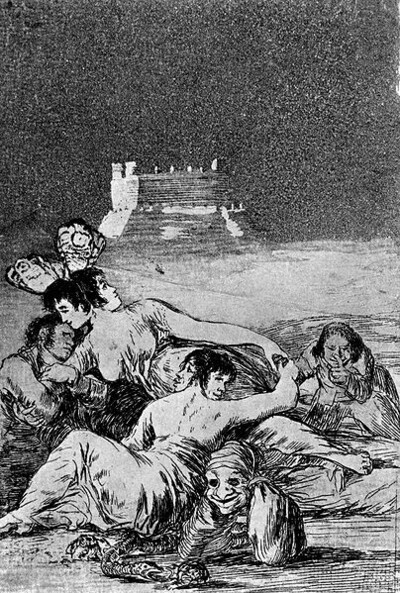- Cronología
- 1815 - 1819
- Dimensiones
- 246 x 359 mm
- Técnica y soporte
- Etching and burnished aquatint
- Reconocimiento de la autoría de Goya
- Documented work
- Ficha: realización/revisión
- 22 Aug 2021 / 08 Jun 2023
- Inventario
- -
See Femenine folly.
There is a print of the posthumous 1848 edition in the Museum of Fine Arts, Boston, and another in the Prado National Museum, Madrid.
A strange scene in which a horrified, wide-eyed woman recoils without letting go of the hand of a man in a white cap who is bending his head down. The grief-stricken male figure has three arms: one pointing towards the woman, one holding his head, and the third pointing towards a preacher to his left. The cadaverous-faced preacher seems to be admonishing the three-armed man, the woman being the object of his harangue, hence her panicked expression. In turn, she is advised by a hooded female figure, perhaps a nun with two faces, one on her head and one on her elbow, possibly related to the saying "to talk with one's elbows". Behind her, a deformed being has two faces, one dejected and the other laughable. On the far left of the composition, another man in an apron wears three faces on his head, two from the front and one towards the back, the front ones with a sad and happy expression and the last one as if dead. In the background there is a vague suggestion of something barely recognisable. It could be an eagle holding something in its talons, a monster carrying someone else to the meeting, or a half-dead tree with a white figure tied to it.
All the characters are linked to each other, clasped by their hands to form a sinister chain in which each one bears his own fate. The multiplicity of faces and limbs is related to Caprice 84. Of lies and constancy, although in this case not as a symbol of hypocrisy but as a stigma of destiny. Man must choose between two options, liberalism and absolutism. The anguish of the decision is embodied in the three-armed, bowed-headed man. He does not know which path to choose in the face of the dark world before him, for the exhortations of the moralists can be as terrible as the temptations they warn against. Others have interpreted the print as a vision of what a marital separation was like in Goya's time.
The light is arbitrarily concentrated on different parts of the figures in order to focus attention on them and emphasise the gloom that envelops them against the aquatint background. This is in two tones, a medium tone on the figures and the ground, and a darker tone in the upper part of the background, which contrasts with the burnishing on the left thigh of the woman in the centre and on the dress of the woman next to her.
The preparatory drawing for the present print, also entitled The Exhortations, has survived.
-
Etchings by Francosco GoyaJohannesburgoJohannesburgo1974
-
1976
-
Grabados de Goya: colección propiedad de la Biblioteca Nacional, que se conserva en su Gabinete deCasa de la Amistad de MoscúMoscow1979exhibition displayed from January 18th to 31st 1979
-
Goya y el espíritu de la IlustraciónMuseo Nacional del PradoMadrid1988from October 6th to December 18th 1988. Exhibited also at Museum of Fine Arts, Boston, January 18th to March 26th 1989; The Metropolitan Museum of Art, Nueva York, May 9th to July 16th 1989, Madrid curator Manuela B. Mena Marqués, scientific directors Alfonso E. Pérez Sánchez and Eleanor A. Sayre
-
Francisco Goya. Sein leben im spiegel der graphik. Fuendetodos 1746-1828 Bordeaux. 1746-1996Galerie KornfeldBern1996from November 21st 1996 to January 1997
-
Goya. 250 AniversarioMuseo Nacional del PradoMadrid1996consultant editor Juan J. Luna. From March 29th to June 2nd 1996
-
Goya grabadorMuseo del Grabado Español ContemporáneoMarbella1996from March 8th to May 5th 1996
-
Zaragoza1996
-
Ydioma universal: Goya en la Biblioteca NacionalBiblioteca NacionalMadrid1996from September 19th to December 15th 1996cat. 309
-
London1997
-
Madrid1999
-
Schlaf der Vernunft. Original radierungen von Francisco de GoyaMunich2000
-
Bilbao2012
-
Goya et la modernitéPinacothèque de ParisParís2013from October 11st 2013 to March 16th 2014cat. 216
-
2022
-
OxfordBruno Cassirer1964p. 399, cat. 263
-
Vie et ouvre de Francisco de GoyaParísOffice du livre1970p. 326, cat. 1596
-
Catálogo de las estampas de Goya en la Biblioteca NacionalMadridMinisterio de Educación y Cultura, Biblioteca Nacional1996p. 244, cat. 393
-
MadridReal Academia de Bellas Artes de San Fernando y Calcografía Nacional1996p. 111, cat. 36
-
Roma Edizioni de Luca2000pp. 140-141, cat. 48
-
ParísPinacoteca de París2013p. 275
-
Goya. In the Norton Simon MuseumPasadenaNorton Simon Museum2016pp. 204-211
-
Museo de Bellas Artes de Badajoz y Diputación de Badajoz2022p. 99


